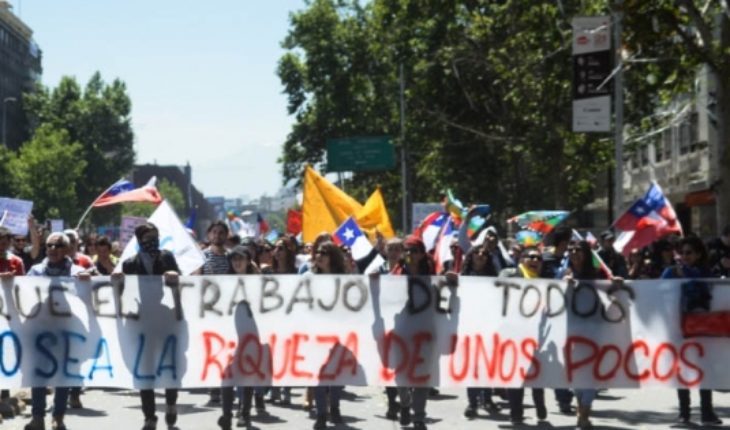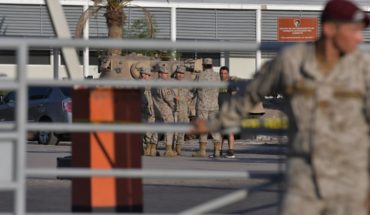During the early morning of November 15, almost all of the parties that once made up the Concertación, the traditional right and their backing parties, plus 3 Broad Front parties and a deputy who signed in a personal capacity, committed the same commitment around the Peace Agreement and a New Constitution. In less than 12 hours the campaign to present this as a triumph of great politics as opposed to those maximalist positions that seek to maintain social mobilization with their resounding of financial abnormality. Although, obviously, the search for a new Constitution is a necessity pointed out by social and political organizations since the beginning of the transition, the elite is able to surprise us once again, for although this time the hands did not appear together together together before the cameras (as in the agreement by the LGE), it was possible that the press conference be lifted so that the mutual hugs and congratulations appear from the political caste, it was possible for the press conference to be raised so that the mutual hugs and congratulations appear from the political caste, it was possible for the press conference to be raised.
However, the surprise of the power groups would come on the same Friday, as social mobilization again erupted on the streets across the country.
But, let’s divide the changes that have happened in recent weeks into crucial questions of the current context. The first is whether social mobilization will be maintained for a fifth week. The second, if the answer to the first is positive, is what can satisfy the demands of the street and the extent to which the elite are willing to give in to them. The third is because of the strategic and tactical reconfiguration of the disputing forces, because when the Broad Front and UDI parties entered the agreement, they changed them.
Last Friday, the fourth was completed since the beginning of social mobilizations, incomprehensible to the country’s elite. What began as a process of civil disobedience in the face of the rise of the Metro quickly ended in a social revolt. Civil disobedience is within the framework of liberal thinking that defends the individual initiative against laws and policies that it considers unfair and tends to give relevance to peaceful resistance: at the most extreme of cases it can destroy public furniture if it is a symbol or serves the power that is considered unfair. However, in the process it was transformed into a popular revolt, characterized by clashes with public force and lack of direction, which makes it difficult to articulate. Indeed, the first week, there was an embryonic level of articulation among those involved in street mobilization. But the history accumulated at three levels by a network of political, social and territorial organizations throughout the country paid off. This story was constituted by the construction of a common program that could be easily transmitted in actions of agitation and propaganda, but with an extraordinary collection of information and theoretical knowledge. Secondly, as a form of resistance to a thankless daily life that is lived at the most basic levels of life: the need to borrow for health, food and housing; the miserable reality of the pension system; humiliation and mistreatment in the transport system; systemic violence of the health system at all levels, from primary care to access to medicines; among many others. And finally, the development of a new form of sociality built from fraternity and fellowship, that not only stays in resistance, but advances in the development of a material power that organizes daily life in the “buying together”, popular schools and pre-university, community radios and its infinite new number of programs, the rediscovery of the mingas to solve problems that need many hands, in short, a creativity that is spread by the interstitials of invisible power, and ineffable to the official language of the media and academia.
It was all these factors that made the popular revolt that was expressed in massive saucepans successful and in the street dispute with the repressive forces that the elite pulled out to protect itself. However, the response from power was inefficient and late. The use of military force was a failure, for the repression of legitimate protest can only be effective if it ends in massacre. Uncensored, such measures are absolutely unpopular. Even more so when used against most people. The scene of military personnel advancing as in a war, against a peaceful march that went up Apoquindo Street, so impacted internationally, that the curfew only had a few hours left. By Friday, November 1, the ghost of the military on the street only frightened parliamentarians and palace journalists. By this time, the popular revolt had constituted assemblies; it had an icon that is not even human (black pacopacos); had articulated the main organizations of workers, environment, student, popular, etc.; it was supported by the world of culture and the arts, producing a new musical repertoire and giving back the culture to populations that were filled with musicians, artists, poets, filmmakers; it had established a logistics chain to support the injured, protect the protesters (the front line), feed those fighting and meet other material needs. By this time, the revolt had become rebellion.
The national strike or stoppage was the culminating moment and the litus test for the social subject in struggle. At this time, the forces that were part of the establishment, but in opposition to the government, had signed an agreement to defend the Constituent Assembly to the end, while the government and the UDI severed the constitution of Pinochet – Lagos. Two days later, the entire Right in the Government and most of the opposition forces signed an agreement at the congressional headquarters in Santiago. What at the beginning of the political crisis seemed like the fantasy of an opium smoker, in four weeks of mobilization, had been possible.
From the point of view of the government, especially National Renewal, it was an excellent way out. First, it allowed us to show settled politicians funded by entrepreneurship alongside the leaders of the 2011 student mobilizations. Secondly, he managed to get the forces considered maximalists isolated, giving way to demobilization in the streets: it is time to leave the streets and dialogue in our neighborhoods, the spokeswoman of government, Karla Rubilar, pointed out. In the third, everything was prepared for the media counteroffensive. Less than five hours after the agreement, a group of young people had managed to coordinate to cover 3000 m2 of Piazza Italia (or Dignity) and put the word peace on the monument of Baquedano. He was even allowed to speak to Gabriel Boric, who was not party president and therefore had no right to use the microphone at the press conference. Unintentionally the deal departed with a media coup from Gabriel Boric to Gael Yeomans, one of the few party presidents who spoke that night. For the morning the Twitter of joy and mutual congratulations among the elite had their television expression in the embrace of the minister of the interior, Gonzalo Blumel, with Sebastián Piñera. The word social peace was repeated as a mantra in the various morning steers, opinion programs and newscasts. But, little by little, the plan began to crumble. Although Twitter boiled in celebrations, there were no cars honking horns of joy in the streets, the only ones who came with the word peace did so escorted by carabinieri, the barricades and mobilizations did not stop in Santiago or in regions and the ordinary people interviewing nuanced the joy with the awkward questions about the end of the abduction in the AFP, the creation of a system of public education, massive, free and quality (relevant to our social reality), the construction of a health system as a right, among many other urgent demands. And, it is that few areas are as expressive that we can be faced with a constitutional scam as the approval by the Chilean State of the TPP – 11. This is easily understandable with an example. Assuming that the right of ownership ceases to be the guiding principle of a new Constitution to be replaced by a system based on human and social rights, it could happen that the right of water given in perpetuity to individuals and companies safeguarded by the TPP – 11, takes precedence over a simple law governing water rights, since it is a treaty signed by the state and not only by the Government. That is to say, if the previous Treaty is adopted and if an area does not win a majority of 2/3 parts, what will take precedence in the areas it regulates, will be this Treaty signed by our State.
This week will be a crucial moment to corroborate whether we are facing a popular rebellion, that is, a collective action that pursues short, medium and long-term ends, with a program perfectly identifiable by anyone, articulated around organizations autonomous to the established power and capable of disputing common sense on a strategic horizon. Three factors will be central to the transformation of revolt into rebellion. The ability to maintain street protest and mobilization, the success of the national stop page or strike on 21 November, and the ability to force Congress to pass a reform program in key areas, or failing that, force the resign from the entire representative political apparatus. This is necessary, therefore, today, repressive violence continues to be unleashed, the agenda legIslandist is clearly anti-social transformations, and its demands and legislative deadlines for profound changes to institutionality have times that benefit an elite with 29 years of unity and experience. The only path that the social subject has emerging to further consolidate the class consciousness that has been defined in recent days is mobilization.
On 15 November, most parties in Congress signed a peace agreement. These agreements are signed to end the wars. But while some may conclude such an agreement, it is difficult to explain to an ordinary person who was at war. Strange war in which the dead only come from one side. General strangers whose flags do not fly in battles in the streets. Strange peace that on the same day leaves a new dead.
The content poured into this opinion column is the sole responsibility of its author, and does not necessarily reflect the editorial line or position of El Mostrador.





